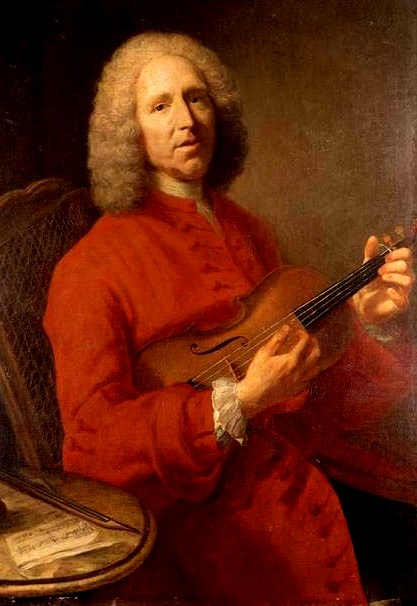
Hippolyte et Aricie
Hippolyte et Aricie (Hippolytus and Aricia) was the first opera by Jean-Philippe Rameau. It was premiered to great controversy by the Académie Royale de Musique at its theatre in the Palais-Royal in Paris on October 1, 1733. The French libretto, by Abbé Simon-Joseph Pellegrin, is based on Racine's tragedy Phèdre. The opera takes the traditional form of a tragédie en musique with an allegorical prologue followed by five acts. Early audiences found little else conventional about the work.
Hippolyte et Aricie
Performance history[edit]
Reception: lullistes versus ramistes[edit]
Tragédie en musique had been invented as a genre by Lully and his librettist Quinault in the 1670s and 1680s.[9] Their works had held the stage ever since and come to be regarded as a French national institution. When Hippolyte et Aricie made its debut, many in the audience were delighted, praising Rameau as "the Orpheus of our century".[10] André Campra was struck by the richness of invention: "There is enough music in this opera to make ten of them; this man will eclipse us all".[11]
Others, however, felt the music was bizarre and dissonant; Hippolyte was the first opera to be described as baroque, then a term of abuse.[10] They saw Rameau's work as an assault on Lullian opera and French musical tradition. As Sylvie Bouissou puts it:[12]
The work[edit]
Libretto[edit]
At the age of 69, Pellegrin had a long career as an opera librettist behind him,[22] so it was unsurprising Rameau should have approached him for his debut, especially given his authorship of Jephté. Distant models for Hippoyte et Aricie were Hippolytus by Euripides and Phaedra by Seneca the Younger, but the most important source was Jean Racine's famous tragedy Phèdre (1677). Such a classic of the Grand Siècle would have been well known to the audience so adapting it might be seen as a deliberate provocation to the conservatives.[23][24]
There are several differences between Hippolyte et Aricie and Phèdre. Some of these are due to differences in genre between French Classical drama and tragédie en musique. Racine observes the Aristotelian unities of time and space: the action of his play is confined to a single location and takes place within 24 hours. On the other hand, each act in Pellegrin's libretto has a different setting. Pellegrin also provides a happy ending, at least for the lovers Hippolyte and Aricie, whereas Racine is wholly tragic; Hippolyte does not rise from the dead.[25] Pellegrin's drama has a major change in focus: Racine's play centres on Phèdre; she is still important in Pellegrin's version, but he pays much more attention to Thésée. For instance, the entirety of the second act is devoted to Thésée's visit to the Underworld. Graham Sadler writes:
Synopsis[edit]
Prologue[edit]
An overture in the typical Lullian style precedes the allegorical prologue set in the Forest of Erymanthus where Diana (Diane in the opera) and Cupid (L'Amour) are arguing who will rule over the forest dwellers. The quarrel is settled by Jupiter who decrees that Love will reign over their hearts for one day every year. Diana vows to look after Hippolytus (Hippolyte) and Aricia (Aricie).
Act 1[edit]
The temple of Diana in Troezen
The story concerns the Greek hero Theseus, King of Athens (Thésée in the opera), his wife Phaedra (Phèdre) and Theseus' son by another woman, Hippolytus. The latter is in love with a young woman, Aricia, but she is the daughter of Theseus's enemy, Pallas. Aricia is the last of the Pallantids, and as such is held captive by Theseus and has been sentenced to take a vow of chastity to Diana. Before she does so, she and Hippolytus reveal mutual love to each other and, defying the will of Phaedra, the priestesses of Diana proclaim that it is unlawful to force her to dedicate her heart to the goddess when it already belongs to another. Phaedra, incensed by the disobedience of the priestesses, threatens to destroy the temple. The high priestess appeals to the gods, and the goddess Diana descends and rebukes Phaedra, forcing her to leave the temple. Phaedra leaves with her only confidant, Oenone, and vents her frustration at the situation. Phaedra, Theseus second wife, has been nursing an illicit desire for her stepson. Arcas brings news that Theseus has made a journey to the Underworld and is likely dead. This means Phaedra may pursue Hippolytus and offer him the marriage and the crown of Athens.[52]
Act 2[edit]
Hades, the Underworld
Theseus descends to Hades to rescue his friend Pirithous, who has been captured when he tried to seduce Pluto (Pluton)'s wife, Proserpina(Proserpine). Theseus has a special advantage: his father, the god Neptune, has promised to answer his prayers on three occasions during his life. The first prayer Theseus makes is to be allowed to reach Hades. At the entrance, he fights with the Fury Tisiphone, but makes it through to Pluto's court. Pluto denies Theseus' request to trade or share the fate of his friend, but allows a trial. When Theseus again loses, he calls on Neptune to free him (his second prayer), and Pluto is powerless to hold him back. As Theseus leaves, however, the Fates (Les Parques) foretell that Theseus may leave Hades but he will find Hell in his own household.[52]
Parodies and influence on later operas[edit]
The opera was parodied twice at the Comédie-Italienne, Paris, once by François Riccoboni and Jean-Antoine Romagnesi (premiered 30 November 1733) and then, during the 1742 revival, by Charles-Simon Favart (11 October 1742). Both parodies went under the title Hippolyte et Aricie.[53]
Carlo Innocenzo Frugoni provided an Italian version of the libretto for Tommaso Traetta, a composer who experimented with mixing French and Italian operatic styles. Traetta's Ippolito ed Aricia was first performed at the Teatro Ducale, Parma on 9 May 1759.[54] Frugoni's version of Pellegrin's libretto was also the basis for a handful of later operas: Ignaz Holzbauer's Ippolito ed Aricia (Mannheim, 1759),[55] Giovanni Paisiello's Fedra (Naples, 1 January 1788),[56] and Sebastiano Nasolini's Teseo a Stige (Florence, 28 December 1790).[57]